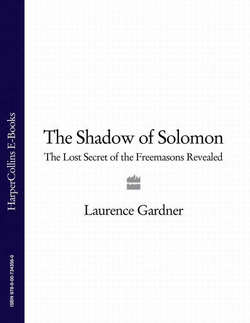Читать книгу The Shadow of Solomon: The Lost Secret of the Freemasons Revealed - Laurence Gardner - Страница 7
1 Ancient Secrets A Magical Heritage
ОглавлениеStories of the biblical King Solomon reside at the heart of modern Freemasonry. They relate especially to the building of his lavish Temple in Jerusalem, where the Ark of the Covenant was housed in the Holy of Holies. Famed for his extraordinary wealth and wisdom, this son of King David from around 950 BC presents an Old Testament enigma. He is greatly revered in Judaic lore, but also criticized for having a number of wives and for allowing many deities to be worshipped within his realm. Notable in the Solomon accounts are his relationships with the King of Tyre and the Queen of Sheba, each of whom supplied him with valuable gifts and a vast quantity of gold to enrich his kingdom of Judah (see page 285).
Outside the Bible, Jewish tradition holds that Solomon was a practitioner of divine technology, with a magic ring and a gem that could cut through stone with silent precision. And it was said that he kept the Ark mysteriously suspended above the ground. In such respects, King Solomon was regarded well beyond his era as a master magician, and he became a much revered figure in Renaissance Europe. As we shall see, the geometry of his Temple was considered to represent sacred perfection; the secret of his stone-cutting and his ability with levitation became subjects of scientific quest, and his passionate interest in gold was a source of constant fascination.
In figurative terms, Solomon holds the key to unlock the secrets of modern Freemasonry, but before the institution was formalized in 1717, the historical connection to his legacy rested with the Poor Knights of Christ and the Temple of Solomon. Commonly known as the Knights Templars, this elite fraternity of Western European knights—a military legation with a monastic structure—was founded in the early 1100s as an ambassadorial fraternity after the First Crusade. The question arises, therefore: Did the masonic movement take its lead from the Templars? If so, how does a modern-day charitable fraternity reconcile with a medieval Order of warrior monks? Or did Freemasonry evolve from stonemasons’ guilds, as is generally portrayed? Perhaps it began with the mystery schools of ancient Egypt, with which there are recognizable similarities. Whatever the case, the same question applies: How does the present institution equate with any of these?
The Bible’s Old and New Testaments have been used for centuries as scriptures which underpin the Jewish and Christian faiths, but that is not how they were originally conceived; neither were the Testaments written as cohesive volumes. They consist of a series of individual works written by different people at different times, eventually brought together with common purpose. The books embody aspects of history which, in the Old Testament, encompass lengthy spans of time, but they have a greater value than history alone in that the inherent stories often relate to truly extraordinary events. The fact that modern Freemasonry (which is neither a faith nor a religion) should focus on certain of these events after such a period of time is intriguing in itself, but it has been an evolutionary process which has brought a variety of past disciplines within the wrap of a single ideal.
In researching pre-18th century Freemasonry in its various guises, it becomes clear that its constituent parts were more romantically exciting as individual subjects than they have become beneath a masonic umbrella which veils them with allegory. Most notable is the science and nature of alchemy—the art of material transposition, which is most commonly associated with gold—along with the manipulation of light waves and, not least in the equation, the techniques of levitation. As recorded in texts from Mesopotamia, Egypt and other countries from the 3rd millennium BC, there is abounding evidence that the technological capabilities of ancient civilizations were far superior to anything credited to them by latter-day educational establishments. The study of such documents not only confirms a good deal of biblical scripture, but sheds a whole new light on the history and origins of Freemasonry. It is time, therefore, to put aside conventional dogma and preconceptions, and to look afresh at the archival material that supports the masonic ideal. To help us in our quest, we should first look at Freemasonry as it exists today and, in particular, at what its formative Constitution has to say about the masonic secrets themselves.
